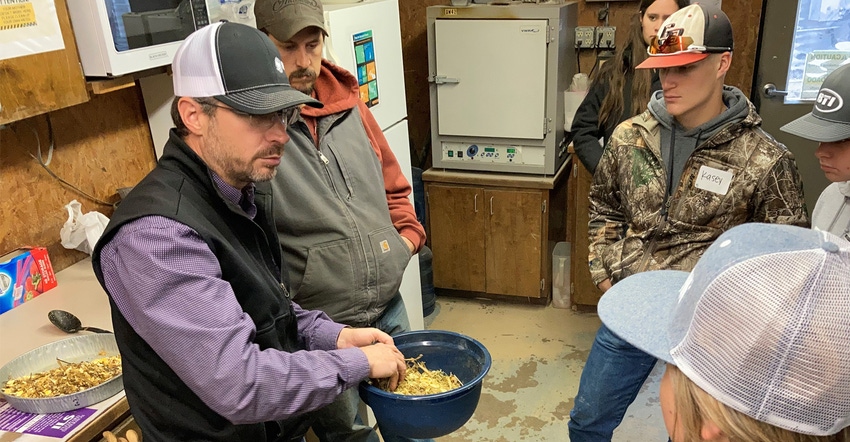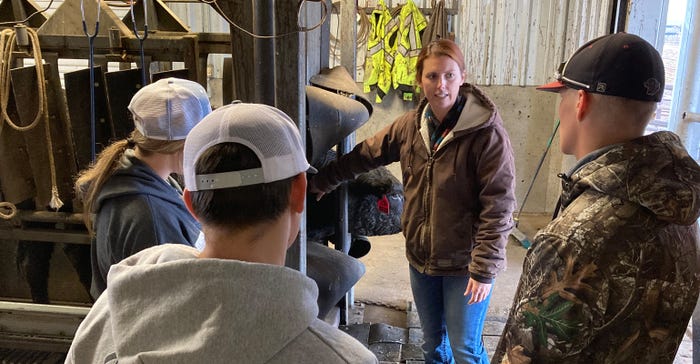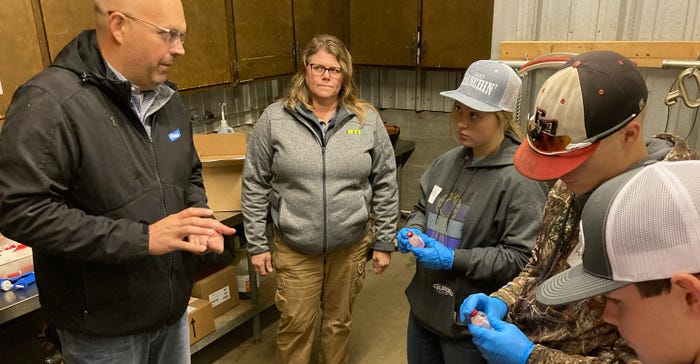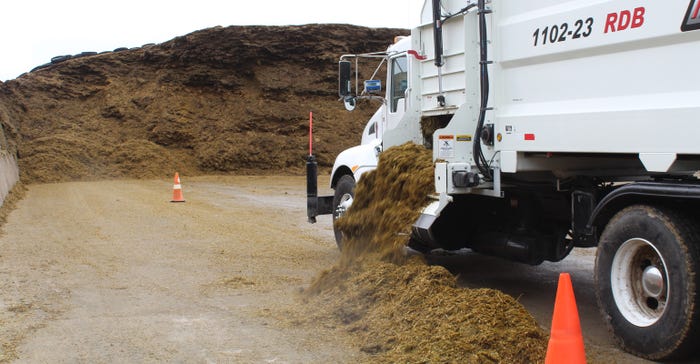
Many in agricultural found their future career paths by working alongside family members on the farm or ranch. But, how do you recruit new generations of employees to work in various farming and ranching careers, when many of them are generations removed from the ag sector?
The Kansas Department of Agriculture is working with industry leaders in the state to offer Immersion Experience Field Days for high school students interested in agricultural careers. The first one was Nov. 3, at Ward South Feed Yard in Larned, Kan. Two more are scheduled in November that will focus on equipment and swine production.
An idea
Russell Plaschka is the manager for the KDA Ag Business Development and Workforce Program. He says the idea for these Immersion Experiences came from a need to connect high school students with industry to give an insight into the various careers open to them in agriculture.
 ANIMAL HEALTH: Brittany Miller (center), with Ward Feed Yard, walks students through the steps the cowboy crew takes when a sick animal comes into the hospital ward at the Immersion Experience at Ward Feed Yard on Nov. 3.
ANIMAL HEALTH: Brittany Miller (center), with Ward Feed Yard, walks students through the steps the cowboy crew takes when a sick animal comes into the hospital ward at the Immersion Experience at Ward Feed Yard on Nov. 3.

“It’s not just a field trip, not just a guest lecture, but we wanted to get as hands-on as we can get to really show the students that these are some really awesome careers in your backyard,” he says. “They may drive by the feed yard, and they may think, ‘Well, the only jobs out there are as a feed truck driver, or as cowboys riding the pens.’ But there’s so much more that happens behind the scenes that they don’t know about.” And maybe, by giving them a glimpse of those activities, it could turn into a career for them, he adds.
Putting it together
Of course, gathering 18 students from four nearby high schools to spend a morning job-shadowing on a busy feed yard needs extra planning for safety — and to make the lessons worth the time off from school. Plaschka says they reached out to Brandon Depenbusch with Ward Feed Yard and Innovative Livestock Services, who was firmly on board. Depenbusch turned to the service providers the feed yard uses to come to the Immersion Experience, and share their career opportunities as well.
 VET MED: Ryan Breiner (left), with Elanco, walks a group of students through the steps to prepare to dose a steer with animal health products. The student practiced intramuscular and subcutaneous shots on grapefruit, just like vet students start out doing.
VET MED: Ryan Breiner (left), with Elanco, walks a group of students through the steps to prepare to dose a steer with animal health products. The student practiced intramuscular and subcutaneous shots on grapefruit, just like vet students start out doing.

For example, representatives from Murphy Tractor, Dodge City, Kan., brought out loader equipment and taught students to safely move feed in a silage bunker. Dodge City Kenworth representatives put students in a feed truck and had them operate it on a test track. There were stations teaching animal health care methodology in the hospital pens, feed technology and software in the conference room, nutrition and processing in the feed mill, and cattle evaluation and marketing in the pens — all hands-on, in real-world settings.
“The plan was to get the students to get the feel of what these jobs may be like,” Plaschka says.
Depenbusch says service companies are a big part of the team that supports feed yards every day, and those careers are important for students to see and experience as well.
Making time
As a former teacher, Plaschka knew that making the Immersion Experiences as hands-on as possible would attract agricultural educators.
“A lot of these teachers understand that the real focus for ag education and FFA chapters and in schools in general is, we’ve got to give the students an opportunity to get a career when they leave high school or college, or whatever,” he says. The goal was to also reach out to career technology programs and senior career classes in high schools without ag programs. And by reaching out to local schools, it shows youth the careers that are in their backyards.
 FEED WAGON: A student practices operating a feed wagon by laying down a line of feed on an imaginary bunk set up between the cones. Students attending the Immersion Experience at Ward Feed Yard were able to test their skills with the guidance of industry experts.
FEED WAGON: A student practices operating a feed wagon by laying down a line of feed on an imaginary bunk set up between the cones. Students attending the Immersion Experience at Ward Feed Yard were able to test their skills with the guidance of industry experts.

Anita DeWeese is the agriculture teacher and FFA advisor at Skyline School, Pratt, Kan. She brought students to the Immersion Experience to get the hands-on experience with career tracks.
“My philosophy is, don’t let school get in the way of the education,” she says. “It’s so vital for students to actually see what goes on.” That helps them connect the classroom learning with what they might do as a career. And that’s even more important for students without family in the ag industry who didn’t grow up working cattle with family.
Come work in ag
For example, Chris Burris, Ward Feed Yard general manager, didn’t have parents who farmed, and he came to the feedlot industry by working for area farmers and judging meats at Kansas State University.
Ron Tessman, technical consultant for Elanco, came out to the Immersion Experience to show students that there are many paths where a veterinary medicine degree can lead them — from clinical work, to laboratory research, to providing support to feed yards and more.
Depenbusch says days like the Immersion Experience not only connect students with where their food comes from, but also are recruitment opportunities for the industry.
“It’s become harder and harder to find employees, whatever industry you’re in,” he says. “But this is an opportunity for us to interact with some of those high school kids that are trying to make their decision in life as far as what they’re going to do.”
About the Author(s)
You May Also Like






